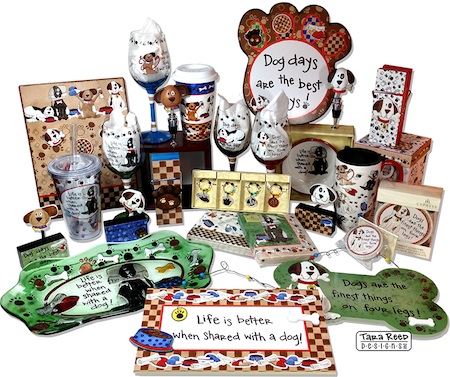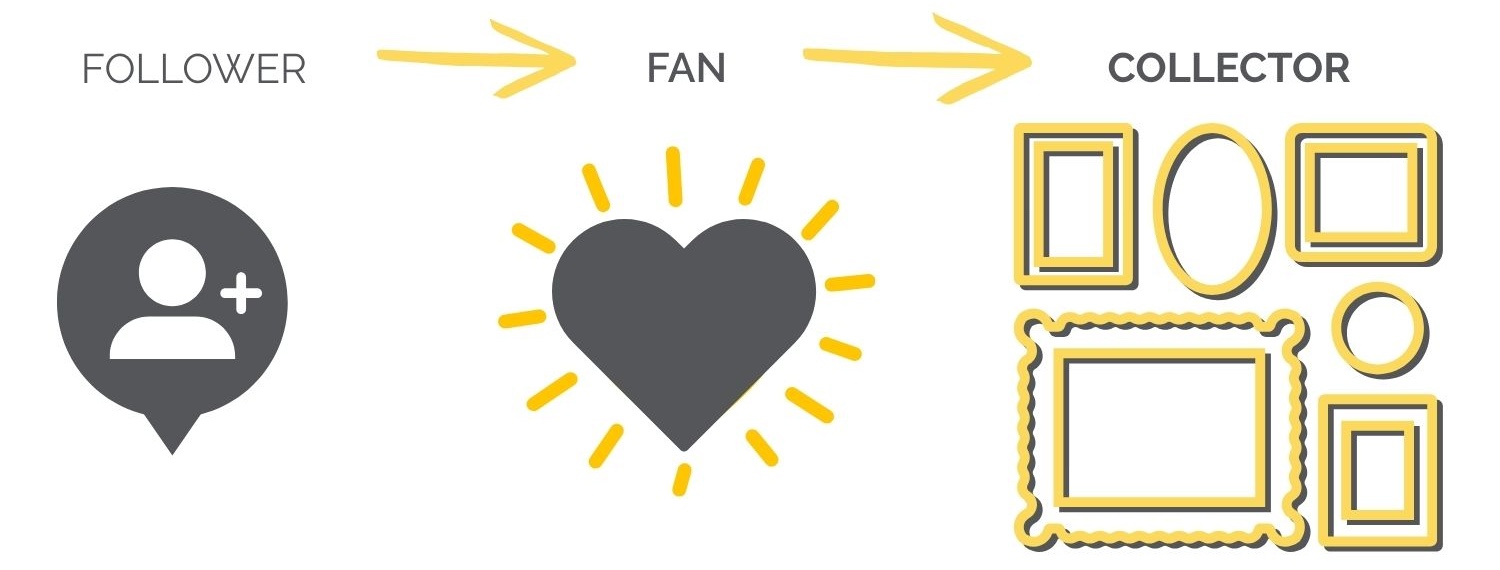Guest Blogger: Tara Reed
So you have heard about this thing called “art licensing” and it sounds pretty good! You can earn income by licensing the same art to multiple manufacturers to use on different products.
“Sounds great!” you think. “Where do I sign up?” you ask.
“Hold onto your paintbrushes!” I say.
Before you start putting a lot of time and energy thinking about the dream that is art licensing, you need to understand the reality of how to succeed in the industry. Creating art for licensing is a little different than the creative process many artists are used to and the day-to-day business might be as well.
So before you decide art licensing is for you, let’s talk about five realities of the business.
1. Mainstream art works best in art licensing.
If you think about art as a long line – with ultra-abstract styles of art on one end and ultra-traditional and portrait art on the other – art that will do well for licensing will fall in the middle of the spectrum.
I’ve said this many times but art that will do well in licensing has to appeal to the masses.
While you need one buyer for an original piece of art, a manufacturer has to believe that hundreds or thousands of people will want to buy a product with the art they choose on it. For that reason, you see less “risky” art on stuff. (That’s how I tell people what I do: “I create art for stuff you buy in the store.”)
If your art falls a bit outside the mainstream, does that mean you won’t make a dime in art licensing?
Not necessarily. You might license your work for a few products but it will be harder to make licensing your art a full-time profession.
[yframe url=’http://www.youtube.com/watch?v=3rUGWYEwXzU’]
It might need to be a piece of your income pie and not the whole thing. The more your art is in the middle of the art style spectrum, the more success I believe you will have in licensing your art.
At the end of the day, there really is no way to know if your art is a fit until you try. I look back at the art I was creating in the beginning and don’t think it is up to par, but if I’d been told it wasn’t good enough and didn’t keep trying, I wouldn’t be here today. Far be it for me to judge!
2. Art for licensing needs to be in collections.
Creating collections means thinking about the bits and pieces a manufacturer would need to create a product. When manufacturers see that you understand and can provide what they need, you are more likely to get an art licensing deal.
A collection could be 4 coordinating fine art images. A collection could be 4 main images with coordinating icons, borders and patterns that can be applied to products.
Each artist creates a little differently but the important thing to remember is that if a manufacturer wants to do a wide range of coordinated products, they need more than one image to work with.
Imagine a set of coastal dishes – complete with serving pieces, trivets, salt & pepper shakers. I mean the works. How exciting would it be on a table if there was one sailboat image on absolutely everything? Not exciting at all – which is why they would need different scenes, icons, maybe some rope borders to wrap around the edge of a gravy boat and a crab & lobster to put on the salt & pepper shaker.

You have to begin to think like a manufacturer – “What art do I need to create in order to give them what they need to make an interesting product line that will sell?” This brings us to reality.
3. The purpose of your art is to sell products.
This is a very commercial way to make money with your art and you need to be okay with that.
If it feels like selling out or you won’t want to be asked to make changes to your art, run away now and find something else to do. You won’t be happy in the art licensing industry.
Products don’t exist to showcase your art. Your art exists to help a product sell.
That’s how it works in art licensing. While we all probably have more than enough coffee mugs, you have probably bought a new one because you connected with the design – it made you feel good, you liked the colors, you liked the message. Something about the ART on the mug made you buy it, even though you could have gone on for years without a new one.
Our job is to create the art that makes consumers open their wallets.
4. You have to be an art creation machine!
Gone are the days where you get an art licensing deal and the product sells for 5-10 years and you sit back and watch the checks roll in.
Consumers want new designs so retailers want new designs so guess what? The manufacturers need new designs from artists like us. It is a “what’s new?” world we live in and the most successful artists in art licensing can create quickly and in quantity.
Speaking of quickly, there will often be times when you will need to create or adjust art on a tight deadline in order to have the chance at having your art licensed. If you don’t like deadlines or making changes in a matter of days (or hours!), then this might not be for you. If you love the challenge of getting your art aligned with what the market needs, you might love it!

5. It takes time to make money in art licensing.
If you have bills that are due next month, deciding to license your art today is not going to help you. It takes time to build your portfolio, connect with manufacturers, get a deal, etc. before you ever see any money coming in.
On average, it takes 9-18 months from the time you sign a contract to the time your royalties start coming in. There are some deals where you will be able to negotiate an advance on the royalties when you sign the contract but other companies who won’t pay advances.
It is up to the artist to decide if they want to work with or without advances or decide if the opportunity is worth the risk of waiting for the sales to go through.
There are many ways to make a living with your art and creativity – art licensing is just one.
Have you dipped your toes into licensing? How much of your income pie does it take up?
About Our Guest Blogger

If the idea of licensing your art still sounds interesting to you, Tara Reed can help. You can learn more on her blog.
Tara recommends artists start on the FAQ tab on the blog or at ArtLicensingInfo.com. There is a wide variety of information from eBooks to audios, teleseminars and more.
I am very proud that Art Licensing Info is a sponsor of the Art Biz Makeover workshop next week – and very grateful to Tara for sharing her expertise.





5 thoughts on “Five Realities of Art Licensing”
I found this super helpful! Especially the practical info about speed/turnaround time/new product, etc. My art is a slow process and while I could pick it up a little now and then, the process is what it is. So the idea of needing to come up with new stuff, in multiple variations all the time — well, now I know it’s just not for me. But more power to you speedily productive folks — thanks for making art we can enjoy in many forms in our daily lives.
Julia –
I’m glad you found this helpful! My goal is always to turn people OFF to the idea of licensing if it isn’t going to fit with your life or art creation speed and style – the sooner the better. There is nothing worse than spending lots of time and energy on something only to find out it’s a lousy fit.
Wishing you much success!
Tara
I was recently approached by a company expressing interest in licensing my art. I checked them out online to see if they exist, and since I could find some basic information on them, I responded. They sent me a sample contract which was very unfavorable for the artist. Buy then they since have gone silent, so I assume that it was either some scam or a mass email that went to every artist on their list and they were not really interested in my work in particular. Do licensing companies operate this way?
Nancy –
Some do… and I would use the term “licensing companies” loosely in that case. Companies have 3 basic ways they get art – they make it in house, they buy it or they license it. Some will license it if it is super favorable to them (as it sounds like the contract you got was) and if an artist seems to know what they are doing and ask questions, they move onto the next. Not the kind of company you want to work for!
Artists shouldn’t be afraid to ask questions and ask for changes to a contract – it needs to be a win-win to work and don’t feel pressured into signing something that isn’t.
Hopefully your next experience will be better!
Tara
the jewelry industry seems to be failing me financially. And as I have a 2yo, I find I am making kids toys during my daytime hours with my son. I think I have a product suitable for licensing, but am not sure. I make big foam cutout decorations for my sons room. He in particular loves robots with big moveable arms and legs. I cutout the parts and do the assembly, he enjoys decorating them. I think a package with a premade kids toy/decoration that a customer can assemble with their child, for their child, would be a super success. Most parents I know are a mill of childrens activities, constantly needing new projects. This product would also be flexible enough that parents can assemble and decorate it for the child as a gift, or with any level of participation from their child, depending on age or ability. What do you think?